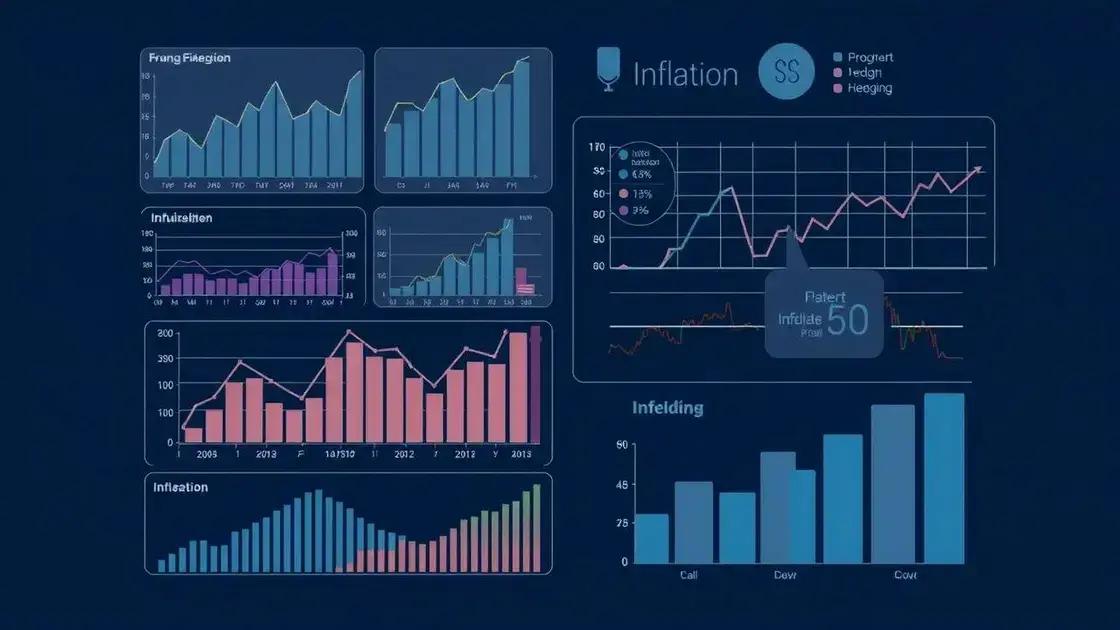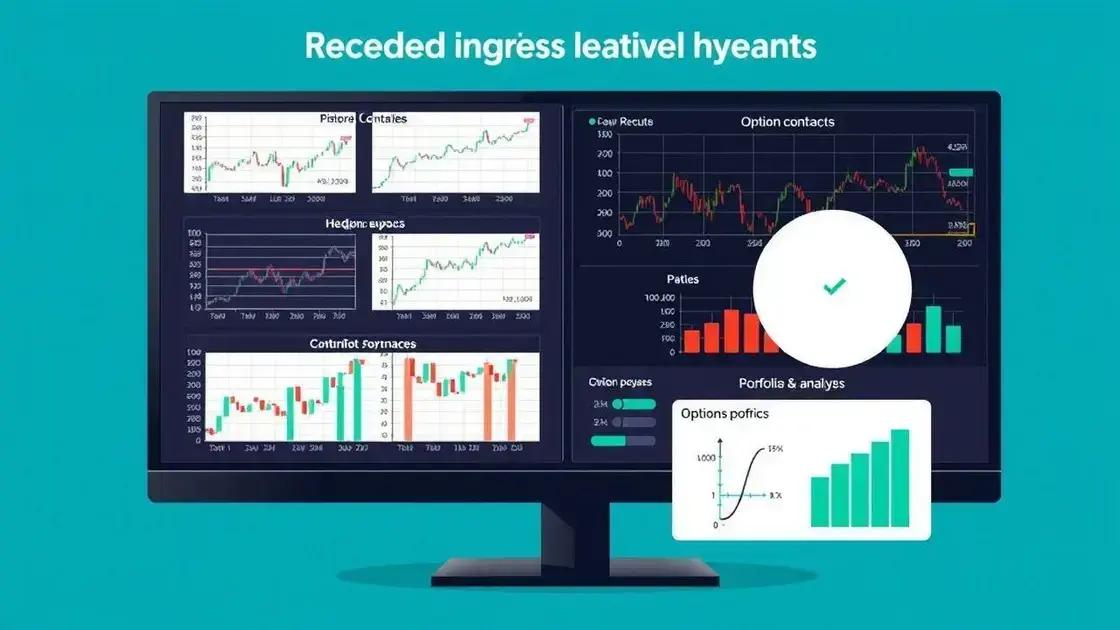Insights on inflation hedging strategies for your investments

Inflation hedging strategies include diversifying your portfolio, utilizing financial instruments like options and futures, and implementing regular evaluations to protect investments from market fluctuations effectively.
Insights on inflation hedging strategies are crucial for anyone wishing to protect their investments against rising costs. Have you thought about how inflation might affect your financial future? Let’s dive into the various approaches that can secure your wealth.
Understanding inflation and its impacts
Understanding inflation is essential for anyone interested in protecting their financial future. Inflation can reduce the purchasing power of your money, making it vital to grasp its causes and effects.
Inflation occurs when the prices of goods and services rise over time. This economic phenomenon can happen for numerous reasons, including increased demand or rising production costs. As inflation rises, your currency’s value diminishes, leading to challenges in maintaining your living standards.
Types of Inflation
There are various types of inflation, which can impact the economy differently. Recognizing them can help you defend against their effects:
- Demand-pull inflation: This type occurs when demand increases faster than supply, triggering price hikes.
- Cost-push inflation: This arises when production costs rise, leading to increased prices for goods and services.
- Built-in inflation: This occurs when businesses raise prices to keep up with higher wages, creating a cycle of escalating costs.
- Hyperinflation: This extreme form of inflation is when prices skyrocket, often at alarming rates, and can destabilize the economy.
Understanding these types of inflation is crucial for making informed investment decisions. As you navigate your financial landscape, keep in mind that inflation can erode your wealth over time. However, recognizing its signs can signal when to take action.
Investors often seek inflation-protected assets, such as real estate or commodities, to help maintain their wealth during periods of rising prices. By diversifying your investment strategies, you can create a buffer against inflation’s effects. Keep an eye on market trends and adjust your portfolio accordingly.
In summary, understanding how inflation works and its various forms is the first step in preparing yourself for its potential impacts on your financial situation. With a solid grasp of these concepts, you can develop effective strategies to mitigate its effects and ensure your investments remain strong.
Diverse hedging strategies to consider

Diverse hedging strategies are vital for protecting your investments against inflation and uncertainty. By employing different approaches, you can secure your assets more effectively and minimize potential losses.
One popular method is investing in real estate. Properties tend to appreciate over time, often outpacing inflation rates. Real estate can provide rental income as well, serving as a steady cash flow source.
Commodities as a Hedge
Another effective strategy is to consider commodities, such as gold and silver. These assets often retain their value during inflationary periods. For instance, when traditional currencies lose purchasing power, precious metals may become increasingly sought after.
- Gold acts as a safe haven during economic downturns.
- Investing in agriculture can also shield against rising food prices.
- Industrial metals like copper may rise when economic activity increases.
Besides tangible assets, financial instruments like options and futures can be beneficial. Through these contracts, investors can lock in prices for future transactions, mitigating the impact of market volatility. Options allow you the right, but not the obligation, to buy or sell assets at predetermined prices.
Moreover, inflation-protected securities are specifically designed to guard against inflation. These government bonds adjust their principal value based on inflation rates, ensuring that your investment grows in real terms.
As you explore these diverse hedging strategies, remember that a well-balanced portfolio includes a mix of these methods. This approach can help you manage risks effectively and provide a more secure financial future.
How to implement hedging in your portfolio
Implementing hedging in your portfolio is essential for protecting your investments from market volatility. A smart approach can help you manage risks and maintain financial stability.
First, assess your current portfolio to identify your risk exposure. Understanding which assets are most susceptible to fluctuations is the first step in developing a hedging strategy. By recognizing these vulnerabilities, you can choose the most effective hedging methods.
Utilizing Financial Instruments
One effective way to hedge is through financial instruments, such as options and futures. These instruments allow you to speculate on price movements without owning the underlying asset. By purchasing options, you gain the right to buy or sell stocks at a predetermined price. This can safeguard against unfavorable price movements.
- Long put options: These provide a way to profit when prices fall, protecting your investment.
- Short call options: Selling these can generate income while allowing you to hold on to your assets.
- Futures contracts: These obligate you to buy or sell an asset at a predetermined price on a specified date, thereby limiting potential losses.
Another approach is to incorporate inverse exchange-traded funds (ETFs). These funds are designed to move in the opposite direction of certain market indices, providing a hedge during market downturns. When the market falls, these ETFs can help offset losses in your portfolio.
Diversification is a key aspect of any hedging strategy. By spreading your investments across various asset classes, such as stocks, bonds, and commodities, you can reduce the impact of any single asset’s poor performance on your overall portfolio. Diversification can help you maintain a balanced approach, minimizing risk while still allowing for growth.
Finally, regularly review and adjust your hedging strategy to respond to changing market conditions. As your portfolio grows and economic circumstances evolve, staying proactive ensures your investments remain protected.
Evaluating the effectiveness of hedging methods

Evaluating the effectiveness of hedging methods is crucial for confirming that your strategies truly protect your investments. You want to ensure that the risks you are trying to mitigate are addressed effectively.
Begin by analyzing the performance of your hedging strategies over time. Look at how each method has responded during different market conditions. For example, did your options protect against significant losses during market downturns? Tracking these aspects provides insight into whether your hedging approach is working as intended.
Setting Clear Criteria
It’s essential to establish clear criteria for evaluation. Consider the following metrics:
- Return on Investment (ROI): Measure the profit from your hedging methods compared to their costs.
- Volatility reduction: Evaluate how well a hedging strategy reduces fluctuations in your overall portfolio.
- Drawdown analysis: Assess the maximum loss your portfolio experiences during a specific period.
Each of these metrics sheds light on different performance aspects. They help you understand how effective your hedging strategies are in minimizing risks.
Another important aspect is to compare the costs of implementing these hedging strategies against the benefits received. Sometimes, complex methods may not yield significant protection when weighed against their costs. A simpler approach might prove more effective and cost-efficient.
Additionally, consider using backtesting. This involves applying your hedging strategies to historical data to gauge their potential effectiveness. While past performance does not guarantee future results, it helps identify trends and behaviors that could signal how strategies may react under future conditions.
Regular re-evaluation is key. As market dynamics change, so should your hedging methods. This ensures they remain relevant and effective against new market challenges. By staying adaptable and informed, you can fine-tune your strategies to enhance your portfolio’s resilience against volatility.
In conclusion, understanding and implementing effective hedging strategies is crucial for protecting your investments against inflation and market fluctuations. By diversifying your portfolio, utilizing financial instruments, and regularly evaluating your methods, you can better manage risks. Remember that the key to successful hedging lies in adapting to market changes and maintaining a proactive approach. Stay informed about different strategies and continuously refine your techniques to ensure your financial future remains secure.
FAQ – Frequently Asked Questions about Inflation Hedging Strategies
What is hedging in investment?
Hedging is a strategy used to offset potential losses in investments by taking an opposite position in a related asset.
How can diversification help with hedging?
Diversification helps reduce risk by spreading investments across various asset classes, minimizing the impact of any single asset’s poor performance.
What financial instruments are commonly used for hedging?
Common instruments include options, futures, and inverse exchange-traded funds (ETFs), which can help manage risk effectively.
Why is it important to evaluate hedging strategies regularly?
Regular evaluation ensures that your hedging strategies remain effective in changing market conditions and help maintain financial security.





